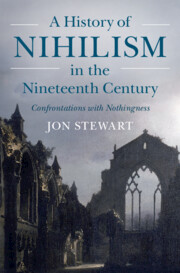Book contents
- A History of Nihilism in the Nineteenth Century
- A History of Nihilism in the Nineteenth Century
- Copyright page
- Dedication
- Contents
- Figures
- Preface
- Acknowledgments
- Introduction
- 1 Jean Paul’s Vision of Nihilism and Plea for the Doctrine of Immortality
- 2 Klingemann and the Absurdity of Nothingness in The Nightwatches
- 3 Nihilism in English Romanticism
- 4 Schopenhauer’s Theory of Human Suffering and Lack of Meaning
- 5 Büchner’s Account of the Reign of Terror as a Mirror of Human Existence
- 6 Poul Martin Møller’s Criticism of Hegelianism and the Danish Discussion of Nihilism
- 7 Kierkegaard and the Indefinability and Inexplicability of Death
- 8 Turgenev’s Portrait of a Nihilist
- 9 Nietzsche’s Vision of the Past and the Future of Nihilism
- 10 The Importance of Nihilism in the Nineteenth Century
- Selected Bibliography on Nihilism
- Name Index
- Subject Index
4 - Schopenhauer’s Theory of Human Suffering and Lack of Meaning
Published online by Cambridge University Press: 10 March 2023
- A History of Nihilism in the Nineteenth Century
- A History of Nihilism in the Nineteenth Century
- Copyright page
- Dedication
- Contents
- Figures
- Preface
- Acknowledgments
- Introduction
- 1 Jean Paul’s Vision of Nihilism and Plea for the Doctrine of Immortality
- 2 Klingemann and the Absurdity of Nothingness in The Nightwatches
- 3 Nihilism in English Romanticism
- 4 Schopenhauer’s Theory of Human Suffering and Lack of Meaning
- 5 Büchner’s Account of the Reign of Terror as a Mirror of Human Existence
- 6 Poul Martin Møller’s Criticism of Hegelianism and the Danish Discussion of Nihilism
- 7 Kierkegaard and the Indefinability and Inexplicability of Death
- 8 Turgenev’s Portrait of a Nihilist
- 9 Nietzsche’s Vision of the Past and the Future of Nihilism
- 10 The Importance of Nihilism in the Nineteenth Century
- Selected Bibliography on Nihilism
- Name Index
- Subject Index
Summary
This chapter examines the nihilistic dimension in the first volume of Schopenhauer’s The World as Will and Representation. It begins with an account of the philosopher’s theory of the will as the fundamental metaphysical principle of the universe. Schopenhauer describes the will as a never-ending inward discord in every living thing that is the result of the constant drive to satiate one’s needs for food, drink, sex, sleep, and so on. This striving is what Schopenhauer calls “suffering,” and he claims that all life is suffering. He emphasizes the nature of human beings as finite and always on the way to death. He argues that time and space are infinite, in comparison to which the human being is a tiny, insignificant thing that occupies only a small space and a short period of time. Schopenhauer recommends the disposition of asceticism as the solution of the constant suffering and striving of the human condition. With asceticism one tries to break the never-ending circle of the will by renunciation, resignation, and denial of the will-to-live. Schopenhauer seems to concede that it is impossible to escape nihilism (even with the strictest ascetic discipline), and in the end everything dies and disappears into nothingness.
Keywords
- Type
- Chapter
- Information
- A History of Nihilism in the Nineteenth CenturyConfrontations with Nothingness, pp. 126 - 148Publisher: Cambridge University PressPrint publication year: 2023



